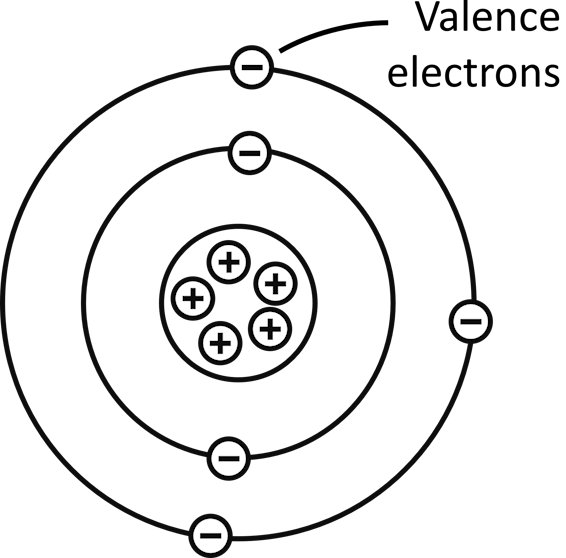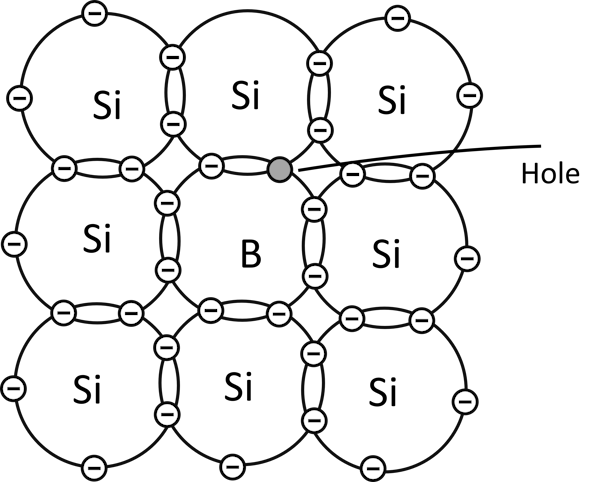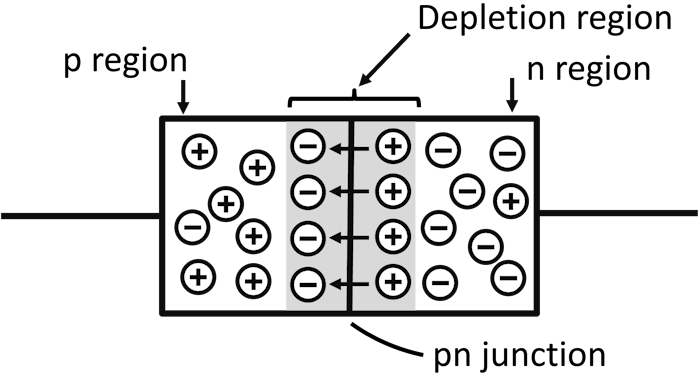How does a pn juction is formed. Depletion region and barrier potential explained.
Introduction.
In electronic engineering, semiconductors e.g silicon and germanium are most material used.
At room temperature semiconductors are poor conductors of electricity, however their conductivity can be improved by increasing its temperature or more important by the process of doping to became useful in electronic engineering.
When a semiconductor is made to conduct well by the process of doping, we call this type of conduction "extrinsic conduction", which means that the conduction is not from semiconductor material itself but it is due the process of doping.
If the temperature of a semiconductor is increased, the semiconductor conduct well, this conduction is from the semiconductor itself due temperature increase, the type of this conduction is called intrinsic conduction.
Some basic concepts we need to understand:
Every material is made up of atoms for example conductors, insulators and semiconductors. Atoms are also made up of electrons, protons and neutrons.
Protons and neutrons are contained inside the nucleus of an atom and electrons orbit around the nucleus of an atom in shells.
Electrons in the outermost shell of an atom are called valence electrons, and the outermost shell of an atom is called valence shell. Valence electrons are the one which take part in bonding and in conduction of electricity.

Electrons exit in either valence band or conduction band in a material. When electrons are in valence band they are not available for conduction, the electrons in valence band are also called valence electrons.
When electrons are in conduction band they are available for conduction and they are also called free electrons or conduction electrons.
In conductors the valance band and conduction band overlap each other, so electrons are always available for conduction whilst in insulators there is a gap between conduction band and valence band and more in insulators.
In semiconductor valence electrons need energy to jump from valence band into conduction band.
How does increasing temperature in semiconductors improves their conductivity?
A pure or intrinsic semiconductor is made up of atoms which have 4 valence electrons or four electrons in the outermost shell. Since their outermost shell is not complete, each atom will share its outermost electrons with four nearby atoms in the material, this process is called Covalent bonding.

In covalent bonding all valence electrons of each and every atom in pure semiconductor material are involved, no electrons are left without forming bonding.
Since all valence electrons are involved in the process, they will be no free electrons left thus creating a chemically stable material. This material at absolute zero temperature will not conduct.
However when temperature of a semiconductor is increased, valence electrons gain energy to break from colavent bonds and became free for conduction, so when this material with increased temperature is connected to a source of voltage current will flow.
NB - Note that electrons gain energy inform of heat and light to break from the nucleus and became free.
What is Doping
Doping is the process of adding a controlled amount of impurities to a semiconductor material to improve its conductivity.
Impurities added to semiconductor material are materials from group five and group three in the periodic table.
Atoms of group five incude phosphorus, arsenic etc. and atoms of group three include indium, boron etc.
If a semiconductor material is doped with atoms of group three the outcome is called p-type material and if a semiconductor is doped with atoms of group five the outcome is called n-type material. P-type and n-type materials are basic building blocks for most electronic devices.
What makes a semiconductor conduct well after doping?
As we mantioned earlier that semiconductor material has four valence electrons whilst atom of group five has five valence electrons and atoms of group three has three valence electrons.
When a semiconductor material is doped with atoms of group five such as phosphorus they is always an electron from every phosphorus atom which left without forming bonding.

The phosphorus atom will share its four valence electrons with four silicon atoms sarrounding it and left with an extra electron without forming bonding.
This election from every phosphorus atom become free and will initiate conduction when the material is connected to a source of voltage.
Since conduction is initiated most by electrons, electrons are said to be majority charge carriers. Hole also initiate conduction in n-type material but at a lesser extent, holes are said to be minority charge carriers in the n material.
When a semiconductor material is doped with atoms of group three such as boron, there is always a hole (proton) which is brought in the material after covalent-bonding.

Boron atoms has three valence electrons whilst silicon has four valence electrons, after doping all the three valence electrons will be used, and since four are required to complete bonding with four silicon atoms sarrounding it, a hole result from every boron atom.
This hole will initiate conduction when the material is connected to a source of voltage.
Since conduction is initiated most by holes, holes are said to be majority charge carriers. Electrons also initiate conduction in p type material but at a lesser extent, electrons are said to be minority charge carriers in the p material.
NB - Note that in n-type material free electrons are created by the process of doping but actually the material has an equal number of electrons and protons, the material is considered to be neutral and also the same applies to p-type material.
When we take a piece of a p-type material and another of n-type material and join them together a pn junction is formed.
P-N juction
A pn junction is a boundary which seperate the joined p-type and n-type materials.

When a p-type and n-type materials are joined together, they are some activities which take place near the junction which cause the creation of a Depletion region.
Depletion region
A depletion region is a region in which the p-type and n-type materials are short of their majority charge carriers. As soon as a junction is formed, randomly moving free electrons near the junction crosses the junction to combine with holes in the p-material.

Recall that the p-type material has equal number of its electrons and protons, it is neutral and also the same to n-type material.
The two materials are regarded as neutral, so when electrons crosses the junction, the n-type material loses electrons causing a creation of holes in the n-type material near the junction.
When electrons crosses the junction to combine with holes in p-type material, since the p-type material has an equal number of electrons and holes, the movement of these electrons will cause electrons to surpus holes resulting in creation of a layer of excess electrons in the p-type material near the junction.
The layers of excess electrons in the p-type material and holes in n-type material form a depletion region.
In the depletion region they are opposite charges on the sides of a pn junction.
When ever opposite charges are near each other, they is a force acting between them, the force between the opposite charges form electric field.
When electrons crosses the junction soon after formation of pn junction this electric field will be gradually increased in strength untill it prevents continual crossing of free electrons and the movement stops.
The potential difference of the electric field is also called barrier potential, For electrons to cross the depletion region they need a force of voltage which is equal or above the barrier potential.
Barrier Potential
It is amount of voltage required to move electrons across the depletion region or through the electric field.
The value of barrier potential depends on several factors which include type of semiconductor material used, the amount of doping and temperature. Typical values of barrier potential for silicon is 0.7V and germanium is 0.3V.
In the next articles you shall see the p-n junction, depletion region, barrier potential in action, why they are important in electronic devices.
PN juction is the basis for various electronic components such as: Diodes Transitors e.t.c, which we looked seperately in other articles